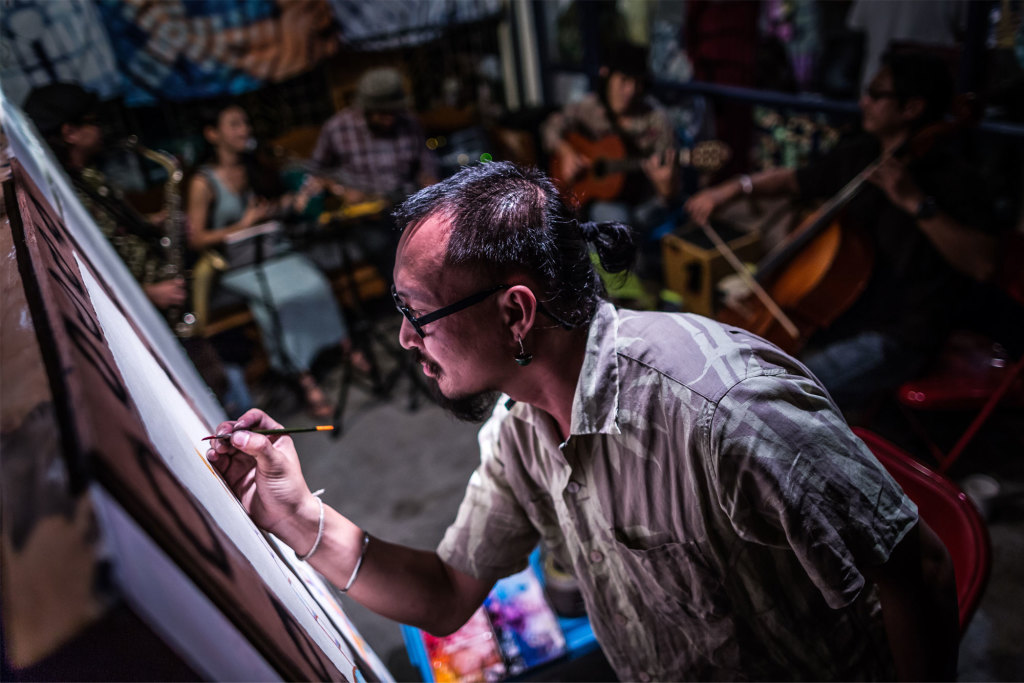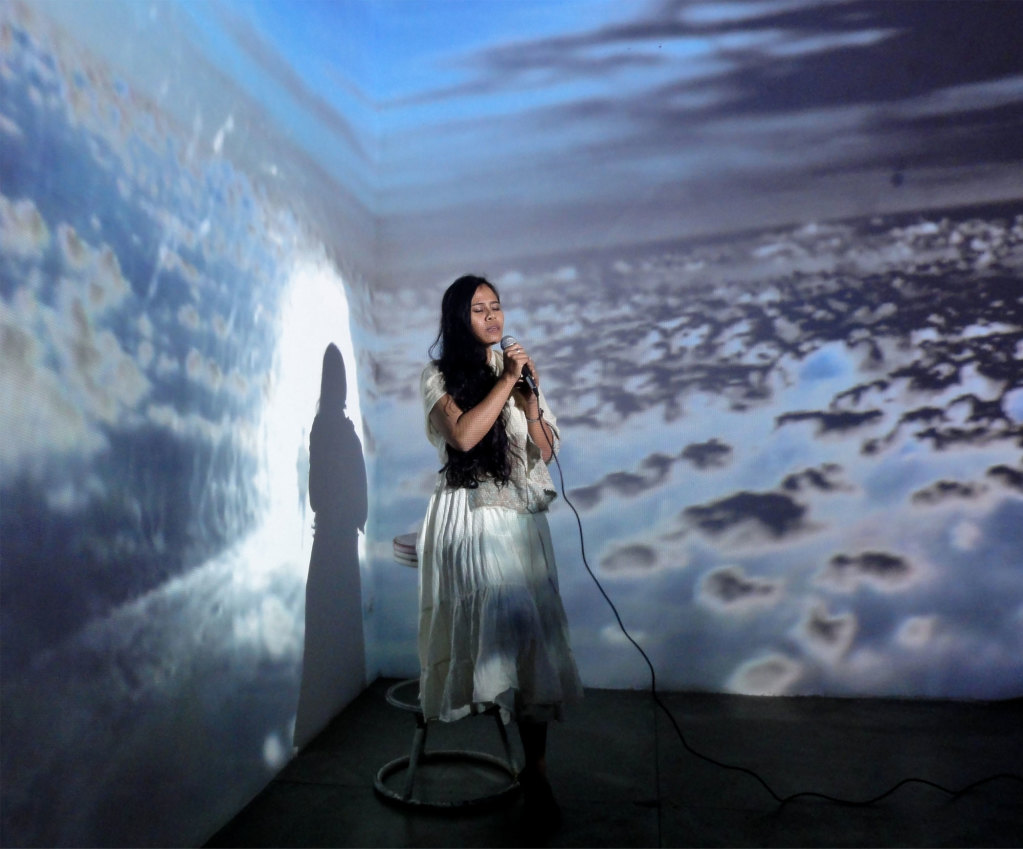At its best, contemporary art asks questions, breaks rules, pushes boundaries beyond expectation and challenges us to think and feel, more deeply. For an artist, it means failing often, and being vulnerable. However, the contemporary arts presence can also make or break a city’s relevance to the international art world.

Is it possible for a city so heavily steeped in ritual and tradition to produce this calibre of conceptual art? Can Chiang Mai tackle its organisational shortcomings to set up the necessary infrastructure for a real arts scene? And would the consequences of such a framework’s rigidity dampen the city’s current creative flow?
No doubt Chiang Mai is filled with creative energy and talented people, but its soft bubble of relaxed vibes can deter a compelling arts scene. To further understand what aspects of Chiang Mai can foster or stunt the growth of a contemporary arts community, one can look elsewhere and compare conditions in Chiang Mai to cities in a similar position. While commenting on the emerging contemporary landscape in Kampala, Uganda, curator Simon Njami hits on a universal truth:
“Art is not just about the artist. It is a whole system that contains different stakeholders. In order for it to exist, these different conditions must be gathered: curators, critics, galleries, museums, fairs and collectors.”

Njami’s words ring true for us in Chiang Mai as well, where a thriving art scene requires much more than just the presence of artists. But how fragile or robust is Chiang Mai’s art scene, really?
Artists based in Chiang Mai typically have a push-pull relationship with the city, they’re attracted to its positive energy and easy lifestyle, but struggle with inadequate support. From poor gallery standards to a dearth of both art critics and local contemporary arts festivals, it’s no surprise that serious local collectors are few and far between.
Originally from Bangkok, Thai artist Chumpol Taksapornchai runs Matoom Art Space, a contemporary gallery in Chiang Mai’s old city. Tua, as friends call him, appreciates the city’s inspiring mix of old and new culture, and the supportive community of artists. Though his distinct paintings attract international collectors and exhibit in countries like Japan and Switzerland, Taksapornchai says there’s still a deep need for “more support from local collectors.” With strong Thai roots and Buddhist values, he remains content reaching out to the global contemporary market from the warmth of his Chiang Mai studio.
Singaporean painter Li Li Tan has lived in Chiang Mai long enough to witness galleries gradually beginning to embrace conceptual art. “In the past, galleries here had a stronger focus on ethnic art, catering to tourists and local buyers. Now, they’re more open to supporting contemporary art, with or without Thai cultural elements.” Art production is also shifting, she says. “More Thai and foreign artists are quietly producing abstract and conceptual art here, and selling to international galleries and buyers.” Tan sees progress happening, if slowly.
And how is the city experienced from an outsider’s point of view?
Brussels-based French video artist Fabrice Croize has been exhibiting a multimedia project, Gaze of Calva, in Chiang Mai for the past two years. When setting up the project, arts organiser Sachie Tsuyuki encountered difficulty in finding sponsors, but received plenty of open-minded support for Croiz้’s experimental brand of video art. “It’s not easy to melt into the local contemporary art scene, but I feel the [venue owners] really appreciate Fabrice’s work. We’re all looking in the same direction.”
As for Chiang Mai’s future, both Croize and Tsuyuki are cautiously optimistic. “From what we’ve seen, there’s big potential for Chiang Mai to become an art hub for Asia, or even the world. But it needs better support from the government and institutes, and more city-organised art festivals. For now, there’s more of a private movement happening,” Tsuyuki says.
While artists carry on with their work, arts organisations like Chiang Mai Art Conversation (CAC), Surface Arts, Rumpueng Arts Space, Documentary Arts Asia (DAA), and Creative Chiang Mai (CCM) do their best to provide resources and opportunities for creative growth.

Artist-run platform CAC keeps the community informed about local practitioners and events; Surface Arts welcomes fresh talent from abroad with their international residency programme; and Rumpueng offers unique exhibitions year-round. On the design and tech side, DAA promotes contemporary photography and video art; and Creative Chiang Mai brings enthusiasts together with events like Chiang Mai Design Awards and CNXP, an annual conference on music, tech, photo and film.
And yet: it’s not enough for a cohesive scene. No central core exists to support and integrate the pieces scattered around the periphery. Mulling this challenge, German-born CCM director Martin Venzky-Stalling admits that, “CAC’s effort aside, Chiang Mai’s arts community is not as strong as in, for example, Chiang Rai, which has Art Bridge. Chiang Mai should really have more large contemporary art events and spaces. Government agencies, by and large, prefer traditional art to contemporary art.”
He echoes the artists, recognising that “Chiang Mai’s diversity, cultural richness, the influx of foreigner and Bangkokians, and the high number of artists and galleries [including private] create a certain momentum. More public support could unlock the city’s creative potential even more.”Sutthirat Supaparinya (Som) from CAC shares the desire to nurture the city’s artistic promise. “We are artists. We want to see Chiang Mai’s art scene and market grow. There’s so many artists living in this province- and many of them are internationally famous- but [we rarely see] highly professional, contemporary art shows offered.” She explains that while the number of art spaces has increased, people generally have no idea where to find them. “Chiang Mai is promoted as an arts and culture city, but art spaces are not part of the tourist destinations or suggestions. How come?”
To combat this, CAC is currently launching a Chiang Mai Art Map, which they hope will draw more visitors to art spaces throughout the city. “When the market grows, artists and art spaces will survive and improve their practice. We believe the art map is an essential part of developing the art scene, so we’ve created one.”
Aside from the ongoing issue of transportation, Som says the main challenge will be whether the individual art spaces offer enough to visitors for them to return. The group’s also set to launch an accompanying mobile-friendly website by the year’s end- not to mention a first edition of Gallery Night Chiang Mai planned for January 2016, in collaboration with TCDC Chiang Mai and Alliance Fran็aise Bangkok.
Unquestionably, these arts organisations make a positive impact on the city’s contemporary cultural production, as do its myriad artists. But with insufficient support and infrastructure from government and institutions, alongside a near absence of strong arts faculties, city festivals, and local collectors, Chiang Mai remains in creative flux.
And so, is Chiang Mai ready to be a vibrant arts hotspot? Will international artists soon flock to make their name here? No. Not yet, anyway- and that’s not necessarily a bad thing.
The arts scene here feels like it’s forever on the verge of becoming something, but that something never quite materializes; as if perpetually bubbling but never reaching a boil. This latent energy of unrealized potential, though, creates a real sense of possibility that permeates the air and underpins the community, faithfully waiting to be absorbed by anyone porous enough to feel it.
